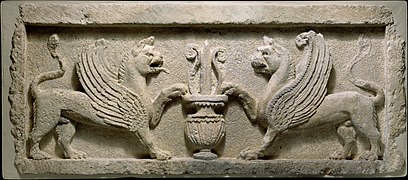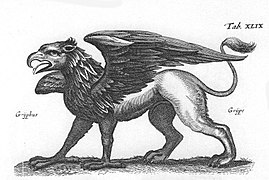Griffin
For him mind’s limiting firmament ceased above.
In the griffin forefront of the Night and Day
A gap was rent in the all-concealing vault;
The conscious ends of being went rolling back:
The landmarks of the little person fell,
The island ego joined its continent.
— Book 1 Canto 3
Griffin figurations can be found in Ancient Egypt as well as in Mesopotamia around 3000 BCE. It is also known in the Minoan period of Crete around 1600 BCE.
The myth of the Griffin is not taken up by Homer or Hesiod in the texts that have come down to us, nor by the Pseudo-Apollodorus who synthesised the most ancient mythology. However, figurations of the Griffin appear in Greek art around 700 BCE and on ceramics as early as the 5th Century BCE.
In the first surviving text to mention the Griffin, Prometheus warns the wandering Io:
The Griffin was a beast with the head and wings of an eagle and the body of a lion.
Door lintel with lion-griffins and vase with lotus leaf ca. 2nd–early 3rd century. The Metropolitain Museum. A.D. Parthian. Public domain
Historiae naturalis de quadrupedibus libri Jonstonus, Joannes. Public domain
In a way, it is a variant of the Egyptian sphinx as it appears in front of the pyramid of Giseh. The latter had the head of Pharaoh and the body of a lion, symbolising total mastery of the ego by a spiritualised mind.
The Griffin indicates total mastery of the ego by a mind that has reached the summit of the overmind, at the frontier of the supramental, where duality ceases. The eagle is a symbol of Zeus, symbol of the highest plane of the overmind.
The Griffins are described as guardians of the gold mines or, as in the Aeschylus text, about the flood of Plouton’s stream that flows with gold, i.e. streams of energy-consciousness that carry the riches of non-duality.
The Griffins are therefore a representation of the guardians of a particular threshold, that of duality or separation which has been introduced in humanity by the advent of the mental. This is why they are the dogs of Zeus: they are the guardians of his kingdom of the overmind before he will be dethroned by the second child to be given to him by Metis – Athena being the first – the one who will lead humanity to the supramental.
Pluto (Hades) is the god of the world of the unconscious, which contains the immense powers of the world that must be conquered with the supramental, the world of matter and of the cells. Hades can be considered as the god of the future.
The one-eyed Arimanians are symbols of omniscience.
Prometheus, the one who puts his quest for the divine first, warns Io, the symbol of the evolution of consciousness, not to try to escape duality, because it is in life, in incarnation, that liberation must be achieved, and not only in the planes of the spirit.
The Griffin Forefront of the Night and Day indicates a passage beyond the guardian of the threshold of non-duality in the spirit, towards a realm where the ego dissolves.

